Born blind, deaf, and mute, shuffling around in the darkness at 30 miles per hour, grasping for food, searching for mates, the life of your average bacteria (or any of the several trillion single-cell organisms on the planet) is invariably nasty, brutish, and short.
Be glad you’re a eukaryote. Like amoeba, insects, chimpanzees, and every other form of complex animal life, we enjoy not only the polymorphous pleasures of multi-cellularity, but also a singular gift, one that distinguishes us from all other known life forms: the ability to share knowledge with each other.
John Locke famously argued that “beasts abstract not.” But in recent years, breakthrough research by sociobiologists and evolutionary psychologists suggests otherwise: that not only do many of our fellow “beasts” abstract, but they have also developed surprisingly sophisticated and highly variegated mechanisms for managing information.
When most of us talk about “information architecture,” we seem to situate ourselves within strictly humanist reference points like graphic design or library science (with perhaps a perfunctory nod to journalism, cognitive psychology, or semiotics).
To approach information architecture from a purely anthrocentric perspective, however, is to overlook the lessons of billions of years’ worth of evolutionary history. We are by no means the first species to grapple with the basic problems of what we now call information architecture: how to acquire knowledge in social groups, how to get the right information to the right party at the right time, how to distill meaning from raw data.
Much as we may like to think of ourselves as belonging to a uniquely privileged species, the fact is that every complex organism on this planet is engaged in a shared struggle with information overload.
As information architects (and human beings) we should be careful of presuming that all our present quandaries surfaced only in the past few years—or, for that matter, in the last few thousand years of recorded human history (a comparative millisecond on the evolutionary clock).
Long before anyone was looking for “godfathers” of information architecture, our fellow species were wrestling with some of the same problems we face today. The real godfathers of information architecture, as it turns out, emerged a very long time ago with the earliest origins of life on this planet.
The memory “switch”
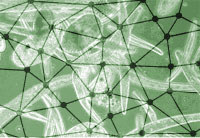
Let’s dial back in time to a hot wet Tuesday in, say, 2,200,000 B.C. Swimming in the briny planetary sea, we find the earliest recognizable living organisms: our aforementioned friends, the prokaryotes.
Now by this time, prokaryotes had been sloshing around in the ooze for something like a billion years. Then, about 2 billion years ago—whether by dint of divine impetus or happy cosmic accident—something remarkable happened: These formerly independent organisms started to collaborate.
To make a long story short: Networks of formerly independent bacteria began forming loose collectives—sharing labor, food, and increasingly deploying specialized cells to complete certain discrete tasks. Eventually, these loosely affiliated organic teams began replicating in tandem, taking on a more persistent form as they became the earliest multi-cellular organisms.
Eukaryotic cells took shape as “host” bacteria started allowing other bacteria to take up residence within them, gradually conscripting the simpler, formerly independent prokaryotes into service. Eventually, these new bacteria began to reproduce in tandem with the host bacteria, forming a replicable organism that evolved into successively more complex life forms—with increasingly specialized tasks.
These early eukaryotes—close cousins of present-day amoeba or slime molds—learned to sense and respond to environmental conditions, adapting cells and forming new cells in response to incoming data from the surrounding environment. One cell would capture a sensory impression and relay it through adjacent cells across its immediate network, tripping amino acid “switches” to signify changes in the environment.
Maverick scientist Howard Bloom has theorized that the advent of multi-cellularity marked the birth of a nascent “global brain,” a worldwide neural network that would continue to grow and evolve for the next two million years. “Informationally linked microorganisms possessed a skill exceeding the capacities of any supercomputer from Cray Research or Fujitsu,” writes Bloom. “Ancient bacteria” had mastered the art of worldwide information exchange.
Meet the original information architects.
Social networks 1.0
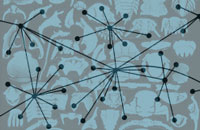 Let’s fast-forward another 1.5 billion years to a rainy Thursday in the Pleistocene. In one of those rare bursts of evolutionary activity (what Stephen Jay Gould famously called “punctuated equilibrium”), a sudden wave of life forms is taking shape during the so-called Cambrian Explosion.
Let’s fast-forward another 1.5 billion years to a rainy Thursday in the Pleistocene. In one of those rare bursts of evolutionary activity (what Stephen Jay Gould famously called “punctuated equilibrium”), a sudden wave of life forms is taking shape during the so-called Cambrian Explosion.
It took a billion years for species to evolve to the point where complex multi-cellular organisms—like shellfish—could emerge. With increasingly elaborate networks of interdependent organs—mouths, hearts, legs, and so forth—individual organisms began to comprise a trillion cells or more.
As life forms became more complex, they also became less directly dependent on each other for survival. As a substitute for the direct transmission of data through chemical relays, these independent organisms began developing a new mechanism for transmitting knowledge: imitation. By observing, responding, and mimicking their peer organisms, these creatures could effectively leverage each other’s senses, experiences, and decision-making capabilities.
The archetypal success story of the Cambrian Era is the trilobite, a wildly prolific organism whose numbers at one point circled the entire planet (its survival as a species was aided in no small part by its predilection for wild, shells-off mating orgies). These organisms were self-contained, self-directed, and less dependent on a constant stream of data inputs for survival. Rather, they had evolved to the point where the individual organism had the resources to ensure its own immediate survival: sensing, responding, eating, and mating. But they were not exactly what you would call independent thinkers.
These new self-directed organisms still relied heavily on their peers for survival and adaptation. As a substitute for the direct transmission of data over the biological network, they began developing a new mechanism for transmitting knowledge: imitation. By observing, responding, and mimicking their peer organisms, these creatures could effectively leverage each other’s senses, experiences, and decision-making capabilities.
These early social learning networks relied not on biological or chemical signals, but rather on imitative learning and the gradual development of behavioral “memes” that could persist beyond the lifespan of any one organism.
Pulitzer Prize-winning entomologist E.O. Wilson coined the term “sociobiology” to describe the study of social behavior from an evolutionary perspective. Wilson’s landmark 1975 book, Sociobiology: the New Synthesis, brilliantly punctured the prevalent scientific view that animal behavior could be adequately explained through the traditional disciplinary filters of biology, chemistry, and genetic inheritance.
Wilson argued that the social learning mechanisms evident in other species required a new perspective, a “synthesis” of biology and the social sciences. Wilson argued that “learned modifications of behavior are not inherited; only the innate predispositions are inherited, and only these can evolve by natural selection.” In other words, social groups can transmit and preserve knowledge through non-biological means, forming “learning machines” with remarkable powers of collective memory, calculation, and distributed decision-making capabilities.
Regrettably, Wilson’s work has been misinterpreted by certain doctrinaire humanists, who have chosen to infer parallels between sociobiology and pseudo-sciences such as genetic determinism or—worse yet—eugenics (the dark science of Nazi genetic engineering). Alas, like Darwin, Wilson’s theories have lent themselves to misuse and misappropriation by groups with political or social agendas. Some feminists, for example, have objected strenuously to the entire discipline of sociobiology on the basis that it seems to offer an apologia for male dominance. Wilson himself would vigorously protest such abuse; he has frequently cautioned against perversions of science in the service of political “advocacy.”
Thanks to the conceptual foundation of sociobiology and, more recently, evolutionary psychology, we are beginning to understand the complexity and sophistication of nature’s super-organisms, some of them seeming to exhibit properties once thought the exclusive province of humanity: language, reason, even the outlines of culture.
For a glimpse of how these early “learning machines” may have operated, we need look no further than some of our contemporary planetary species.
Hive minds
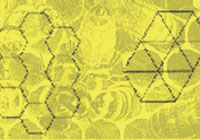 Perhaps the most widely studied examples of nature’s collective learning machines are insect colonies. Ants and bees in particular exhibit remarkable powers of collective reasoning and an ability to accumulate and share sensory data in social groups.
Perhaps the most widely studied examples of nature’s collective learning machines are insect colonies. Ants and bees in particular exhibit remarkable powers of collective reasoning and an ability to accumulate and share sensory data in social groups.
Wilson devoted much of his career to studying the behaviors of ant colonies, which perform seemingly complex feats of calculation and geometry, and elaborately orchestrated group warfare.
Throughout the insect world, colonies of individual organisms appear to exhibit powers of reasoning seemingly not predicted by the capabilities of a single organism. Douglas Hofstadter first applied the term “emergence” to the behavior of ant colonies in his landmark essay “Ant Fugue,” in which he described the dual nature of individual ants as both functioning organisms and as, in effect, signals.
In his 2001 book Emergence, Steven Johnson explored emergence theory as a context for explaining the self-organizing properties of internet communications, and as a construct for self-directed software agents in a future, more intelligent incarnation of the World Wide Web.
While a few software developers have attempted intriguing experiments at modeling software after the distributed behaviors of ant colonies, we should bear in mind that that the essential mechanisms of colony behavior cannot be solely explained in terms of mechanistic or mathematical models. Wilson argued that insect colony social behavior must be properly understood as “an idiosyncratic adaptation” to the surrounding environment, rather than a purely mechanical operation.
In other words, these behaviors constitute distinctly social responses, transmitted across generations through an elaborate dance of imitative learning and adaptation. There is another force at work here: information.
Monkeys in the mirror
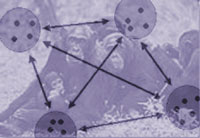 Ever since Carl Linnaeus boldly decided to group humans with monkeys and apes into a family he designated “primates,” we have looked to these close evolutionary cousins for clues to our own behavior patterns.
Ever since Carl Linnaeus boldly decided to group humans with monkeys and apes into a family he designated “primates,” we have looked to these close evolutionary cousins for clues to our own behavior patterns.
Although we may tend to think of “culture” as a uniquely human trait, numerous primate studies have revealed the presence of localized social traditions, rudimentary language, and the facility for transmitting learned knowledge across generations.
Dutch primatologist Frans de Wahl recounts an experiment in which he introduced a group of rhesus monkeys—a particularly argumentative, pugnacious group—with a troop of more even-tempered stump-tailed monkeys. Within a few months, the rhesus monkeys “developed peacemaking skills on a par with those of their more tolerant counterparts” through imitative learning and ritual displays. Most importantly, the rhesus monkeys carried on these behaviors long after they had been permanently separated from the stumptails. In other words, social transmission of knowledge effected a permanent change in group behavior.
All primate cultures seem to rely on learned—rather than genetically determined—social arrangements, which often vary between different social groups within the same species (as demonstrated in numerous chimpanzee studies).
While these social knowledge transmissions have no external symbolic manifestation—other primates don’t write books or create external symbolic language—they do nonetheless create, store, and transmit social knowledge that persists across generations: surely a manifestation of the same impulse that drives us towards information architecture.
The disintegration of hierarchy
 Throughout most of human history, information has flowed through small groups in ways not so different from the imitative social learning mechanisms evident in other primates.
Throughout most of human history, information has flowed through small groups in ways not so different from the imitative social learning mechanisms evident in other primates.
Only in the past four thousand-odd years of recorded human history have we developed the capacity for symbolic representation—and with it, a new externalized construct of “information.”
The rise of written language paralleled (and facilitated) the rise of the modern institution: churches, governments, universities, and corporations, to name a few. As these larger collective entities began to supplant the close-knit family and kinship bonds of earlier social groups, the institution also took on a new function as a container for shared knowledge—what Francis Fukuyama has called the “knowledge bureau.”
Fukayama has argued that the rise of the “knowledge worker” in Western society, coupled with the liberating effects of communications technologies, is gradually undermining these institutional hierarchies that have characterized our collective social experience for the past four thousand years. And with the fragmentation of institutions comes the upending of traditional knowledge bureaus.
In The Social Life of Information, John Seely Brown and Paul Duguid draw the distinction between “fixed” sources of information that are typically the province of institutions (such as government records, books, and other documents) and the “fluid” information that tends to emanate from individuals and small groups—(such as email, instant messages, and threaded discussions).
Howard Rheingold has recently chronicled the rising tide of fluidity in newly evident social phenomena like “smart mobs” and “flocking”—social behaviors in which large groups of individuals act in seeming concert, without any apparent organizational hierarchy at work. From recent political riots in the Philippines to more recent mass events like the Nigerian Miss World Pageant riots, or the unprecedented wave of recent anti-war protests, we seem to be undergoing the early stages of a dramatic transformation in the behavior of social groups.
If we look closely at the behavioral dynamics of these new behavior patterns—widely dispersed, non-hierarchical social relay systems—we can easily recognize the contours of earlier patterns of communication and knowledge-sharing evident in every species to the earliest forms of life on this earth. While these recent phenomena may seemingly result from modern technologies, they appear to manifest some very old patterns of social learning and knowledge sharing.
From social networks to social capital
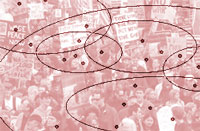 Today, the practice of information architecture remains primarily an institutional endeavor, driven by the needs of corporations, governments, and educational institutions.
Today, the practice of information architecture remains primarily an institutional endeavor, driven by the needs of corporations, governments, and educational institutions.
Today’s information architects are the heirs of yesterday’s scribes, clerks, and clerics: laboring to acquire, store, and disseminate knowledge for the sake of humanity, but ultimately in the service of institutions.
Now, some IAs may protest that assertion, arguing that the practice of IA is not about the organization, but about “the user.” But I would argue that if we look closely at that elusive user, we may discover not real human need but a flimsy straw man, a construct designed to serve an intrinsically institutional agenda.
What evolution teaches us is this: in order to understand the deeper roots of our need to generate and manage information, we need to look beyond the individual organism, towards the social groups that drive the mechanisms of evolution and adaptation for all species.
In recent years, the term “social software” has gained currency as a rubric for describing a new breed of software: groupware, social network visualization, discussion lists, and a host of other collaborative tools that support the needs of small, self-selected groups of individuals rather than organizational imperatives.
The real promise of social software has less to do with commercial productivity, and more to do with generating social capital: trust, social engagement, and the development of sustainable knowledge-sharing mechanisms that enable our advancement and evolution within social groups.
What does this mean for information architects? Over time, I believe we may find ourselves progressively less focused on solving the problems of institutions, and increasingly attuned to the needs of groups: a new kind of information architecture—and a very old one too.
![]()
Brown, John Seely and Duguid, Paul. The Social Life of Information. Harvard Business School Press, February 2000.
Johnson, Steven. Emergence: The Connected Lives of Ants, Brains, Cities, and Software. Scribner, September 2001.
Wilson, Edward Osborne. Sociobiology: The New Synthesis. Harvard University Press, September 1975.

This was a thoughtful, well-researched, well-crafted synthesis. Nicely done. Thanks.
This kind of thing seems like a lot of fun to think about, but I wonder what the usefulness is? I’m not sure what to take away from it: networked information exchange happens on many scales and among many types of creature, so don’t forget to look at the bigger context?
It might be useful to look at where other people have written about drawing inspiration from the natural world (like Benyus’ Biomimicry http://www.biomimicry.org/). Although they’re usually talking about learning from physical structures in nature.
Of course everything can bear information in it. it depends highly on the subjective perception of an individual what is to become “information”. information is nonexistant on its own. individuals can aggregate to groups. so groups can handle information.
but i am not quite sure what social behaviours and social evolution has to do with IA (probably my english is not good enough to understand all your points :-).
but i agree with you that it could be fairly interesting to look up how nature deals with IA. and we don’t have to take the long jouney to the evolutionary origins of live (at least not on the first day of our excursion). i am talking about genetics. what all the different kinds of DNA or RNA harbor is pure data. this data is highly effective structered so that it bears lots of information in it. and you really have to talk about information “architecture” because there are real physical architectural units just build to present and handle information.
i studied human genetics and, as most biologist nowadays, find myself working in a medium-sized internet company, doing something completely different. so, i am looking forward to read your next article on that matter.
In paragraph 5, why is “anthro-centric” used rather than “anthro-po-centric?”
For decentralized and fragmented organizations, such as colleges and universities), this kind of approach is often the only type that will embrace, or at least describe, the organization.
In these orgs, content experts are at the bottom of the traditional communications hierarchy (i.e. faculty, staff, students) and rarely are given a platform to communicate externally. However, those individuals and the collaborations between them are what gives life to the institution. They “are” the institution…not the facilities and the like.
Clearly, strategic goals such as admission and development need to be addressed from an institutional level…but the remaining content should be evolved rather than determined. As scary as it sounds to let a site “build itself”, institutional goals will met more naturally and the unique characteristics of the institution will emerge. There are no assumptions.
The communications people rarely are able to keep track of the wealth of information that is running through the institution at all time…and it is this life blood which defines any institution.
It’s a tricky proposition…but if you can allow the publishing of content to occur at the grassroots level so to speak, but still ensure usability…then you can actually give a real voice to an organization…rather than the prepackaged kind that you see on 99.9% of educational communications.
The keys, in my opinion, are technical transparency of the internal content management tools and careful development of the navigational schemes…oh yeah and the ability and courage to think more like a scientist and less like a librarian.
A nice but very selective overview of somewhat controversial topics which take whole books to cover. It’s fun as mental bubblegum, but doesn’t really recognize the reality of our capitalist system.
There are some really big big mistakes in this text. First, a “poor” procaryote is not “simple” at all. Okay, it seems to be an easy to understand organism because it is single cell. What can be simpler than a single cell? Well, even single cells contain complex biochemical chain reactions which are not easy at all. They contain complex molecules, too. They contain RNA. They even share information (so-called horizontal transfer of genes). As we know today, they are able to “read” human genes (biotechnology uses this as a basis). They react on changing environment conditions. Every form of life can do this!! This is not typical for “higher” multicellular organisms. There more such mistakes … well, trilobites don’t have “peer mates” or something. They do not imitate each others. Have you ever watched a trilobite? They are still living on the US-cost. All in all, the article seemed to be a nice and well-researched but in my opinion it is something to have some fun on rainy sunday afternoons.
Author’s Response:
First, thanks to everyone who’s commented on the article.
I’ve refrained from posting comments here so far, since I’ve been curious to see how readers’ collective judgment would evolve without me defending the piece. But since I’ve now been accused of making factual errors, I feel obligated to respond.
My opening gambit about prokaryotes certainly wasn’t meant to over-simplify things, or to suggest that prokaryotes had no ability to transfer cellular data. But I stand by my assertion that only eukaryotes have gone on to develop the capacity for social learning.
As for trilobites, I confess I don’t quite understand the comment about “peer mates”; but my assertion that trilobites engaged in imitative behavior is correct. I would invite anyone to explore the growing literature of paleopsychology and memetics research, where trilobites are almost always cited as the prime exemplar of group learning during the Cambrian era.
Finally, I certainly wouldn’t argue with several readers who have suggested that some of the themes in this article deserve deeper exploration. I’m working on writing a longer piece at the moment; and the feedback to date – both positive and negative – has been quite instructive. So, thank you.